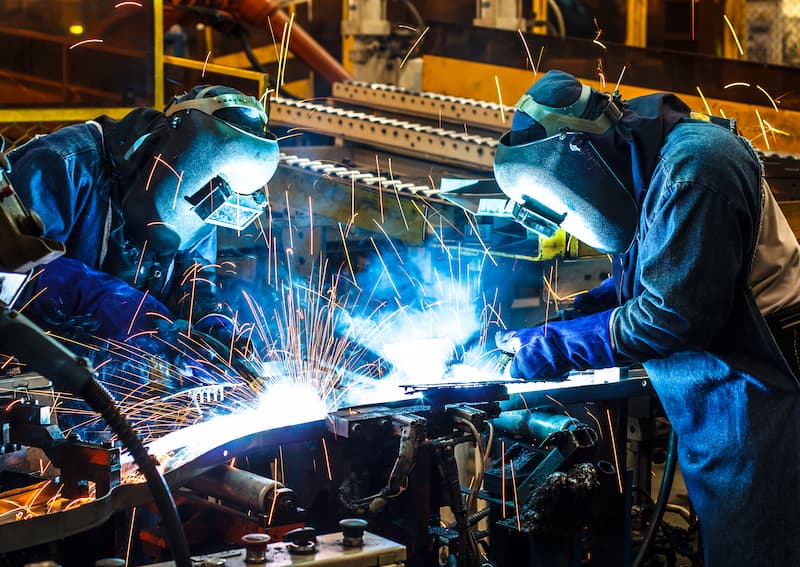Welding is a fabrication process that joins two or more metals using heat, pressure, or both to form a strong, permanent bond. Weldable materials generally include metals and thermoplastics, but welding other materials like wood are also possible.
Modern welding was pioneered in 1800 when Sir Humphry Davy struck an electric arc using a battery and two carbon electrodes. Since then, welding has developed into highly versatile forms, paving the way for its use in a variety of applications, from small DIY projects to large-scale manufacturing assemblies.
Different welding processes are a staple in most industry sectors and thus, let’s understand how these work and the principles behind them.
How Does Welding Work?
Welding is a high-heat process that melts the base materials. This is also the main differentiating factor from soldering and brazing where only the filler material is melted and no fusion between the parent materials occurs.
Welding works by joining two or more workpieces together at high temperatures. The heat causes a weld pool of molten material which after undergoing cooling, solidifies as one piece, forming a weld. The weld can even be stronger than the parent metals.
There are many different types of welding but all of them involve heat or pressure to melt the metals to create welded joints. The source of heat or pressure may vary depending on the application and the material used.
Metals are known as the most commonly welded materials, given their easy and straightforward welding principles. Plastic welding is also quite widespread but welding wood is just in its nascent phase.
The welding process is influenced by many factors, such as the need for specific additional tools, shielding gases, welding electrodes and filler material. Let’s have a closer look at some of the most common welding methods used today and find out what makes each of them unique.
Different Welding Types
Although the fundamental concept of welding is rather simple, we categorise them by the energy source used. As we break these subcategories down even further, we can dive deeper into the operating principles behind each separate method.
Arc Welding
Arc welding includes some of the most well-known welding processes and these are most likely what come to mind when visualising the welding process in general. In these processes, an electric arc generates heat between the electrode and the metal to be welded. The electrode may be consumable or non-consumable, and its power source can vary from alternating (AC) to direct current (DC).
MIG/MAG Welding
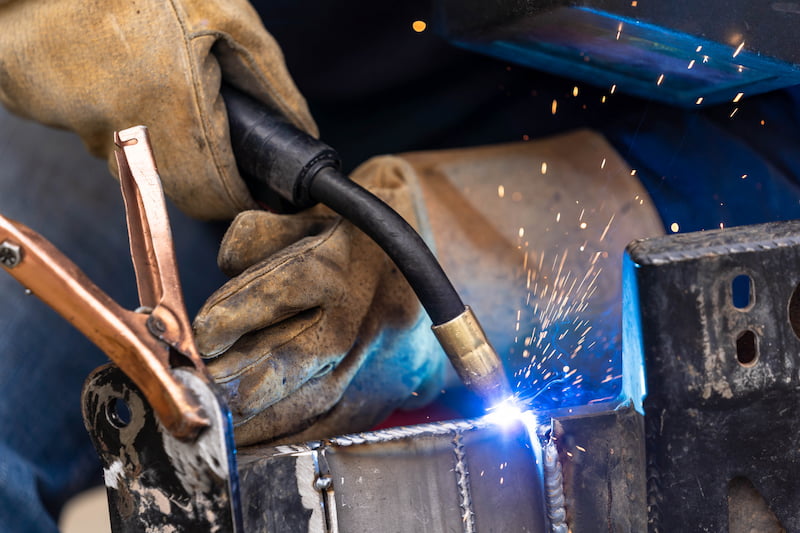
Gas metal arc welding (GMAW), also known as MIG/MAG welding (metal inert gas/metal active gas), uses a continuous wire electrode fed through a welding gun. As the electric arc melts the electrode wire it is then fused along with the base metals in the weld pool.
Shielding gas is simultaneously supplied to the weld area to create a protective layer from atmospheric contamination.
The simplicity of this welding technique allows it to be one of the preferred choices for industrial welding, manufacturing, construction and for the automotive sector. GMAW has pretty much replaced atomic hydrogen welding (AHW), mainly because of the availability of inexpensive inert gases.
TIG Welding

Tungsten inert gas welding uses a non-consumable tungsten electrode and an inert shielding gas. In contrast to MIG/MAG welding, using separate filler metal in TIG welds is optional and depends on the project.
The gas tungsten arc welding (GTAW) process creates accurate and high-quality welds with great penetration making it suitable for several applications, such as aerospace and automotive industries. While TIG welding has a steeper learning curve than MIG welding, the many adjustable features and functions of a TIG welder make it a very versatile process.
Shielded Metal Arc Welding
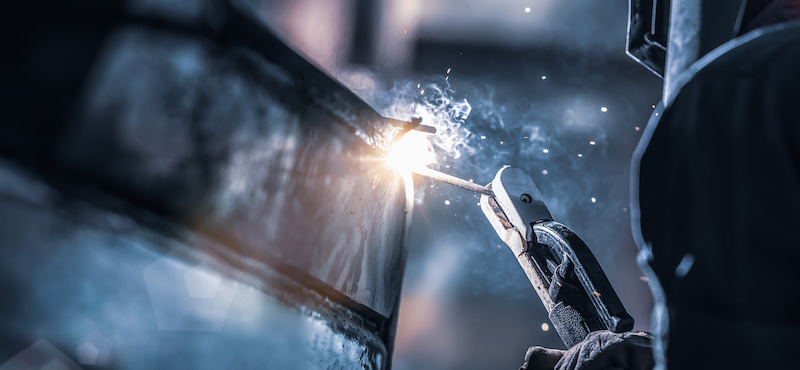
Shielded metal arc welding (SMAW) also known as manual metal arc welding (MMAW/MMA) or just stick welding, uses a consumable flux-coated metal electrode to join metals.
As we strike the electrode with the base metal, it creates an arc that melts down the materials in the weld pool. The flux releases a shielding gas to protect the weld metal from contamination. Slag deposits are removed after the cooling process using common shop tools such as a wire brush.
SMAW is a reliable welding process that offers versatility in welding different metals and various conditions. It’s also portable and lightweight, with no need for a gas tank as with some of the other welding methods mentioned previously. The welding electrode comes as a welding rod, making it perfect for tight spaces and awkward welding positions.
Flux-Cored Arc Welding
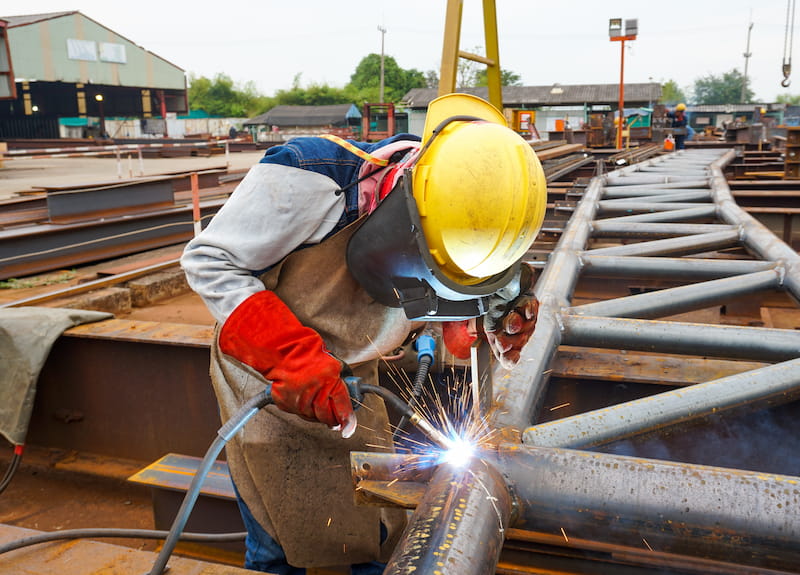
Flux-cored arc welding (FCAW) is an automatic or semiautomatic process that uses a welding electrode that contains a flux core that acts as a shielding agent. Additional protection from contaminants is called dual-shielded FCAW, wherein a shielding gas is used along with the flux-cored electrode.
FCAW is well-suited for ferrous metals and operations requiring little pre-cleaning. It is best used for repairs, pipes, shipbuilding, outdoor and underwater welding because of its incredible protection from external conditions.
Although FCAW and GMAW are two separate welding types, the only major difference lies in shielding the weld zone using electrodes and shielding gases.
- Personal account manager
- Quality assurance
- Payment terms for companies
- On-time delivery by Fractory
Gas Welding

Gas welding, or oxy-fuel welding, is one of the oldest forms of heat-based welding that uses oxygen and fuel gases to join metal surfaces. This welding method typically uses acetylene or gasoline as its fuel gas, which makes it known as oxyacetylene, oxy-gasoline welding. Other gases, such as hydrogen and propane, can be used to braze and solder non-ferrous metals but they do not generate enough heat to melt steel.
A unique property of gas welding is that it doesn’t run on electricity, making it a viable choice if it isn’t available. This welding method allows fusion between ferrous and non-ferrous metals and allows the welding of both thin metal sections and steel plates. The process is relatively easy to learn and low-cost in nature.
The same equipment can be used for oxy-fuel cutting when adjusting the gas flow to manipulate the flame profile.
Plasma Welding
ARVE error: url: https://www.googleapis.com/youtube/v3/videos?part=snippet%2Cstatistics&id=588EJInHLsc&key=AIzaSyAQ7WFzTAUrOX-FjsIrFS3JwZBFzgIvloc Status code 200 expected but was 403.
Plasma arc welding works in a similar concept to TIG welding, but the torch is designed in a manner that the inert gas exits the nozzle at a higher velocity in a narrow and constricted path. Plasma is created as the arc is struck with the inert gas, ionising as it flows into the region. This leads to welding temperatures up to 28000 °C, which can melt any metal. The high operating temperatures of plasma torches (along with gas torches), enable the processes to be used for welding and cutting.
Plasma welding is one of the cleanest welding techniques since the highly concentrated heat creates a narrow bead, which results in minimal spatter. It’s perfect for applications such as aerospace manufacturing that require pinpoint precision. Plasma welding is one of the most sought automated welding processes since it operates at low running costs while providing accurate and neat welds.
Submerged Arc Welding
ARVE error: url: https://www.googleapis.com/youtube/v3/videos?part=snippet%2Cstatistics&id=H6QGLGJ-BOE&key=AIzaSyAQ7WFzTAUrOX-FjsIrFS3JwZBFzgIvloc Status code 200 expected but was 403.
Submerged arc welding (SAW) works similarly to SMAW, which protects the weld metal by using flux. The welding technology behind this automatic or semiautomatic welding process uses a separate flux hopper that deposits granular filler metal to the weld.
This welding technique creates stable and clean welds, which makes it better than most conventional manual welding processes. It’s an excellent choice for metals such as nickel, steel, and stainless steel and is often used for manufacturing pipes, pressure vessels and boilers.
Resistance Welding
Resistance or pressure welding uses the application of pressure and current between two metal surfaces to create fusion. Workpieces are placed in contact together at high pressure with a current passing through the contact point. The resistance in the metals generates heat which fuses together the metal surfaces of the workpiece.
Spot Welding
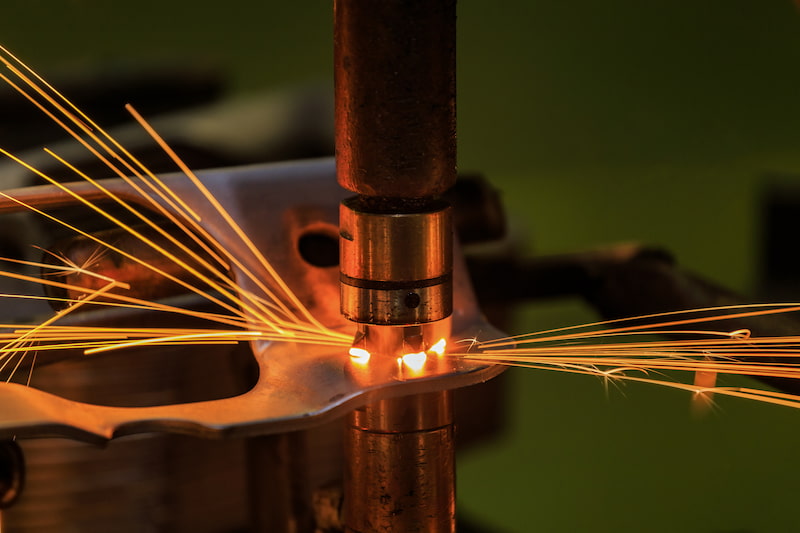
Resistance spot welding (RSW) uses two electrodes to press together overlapping metals while a welding current is applied through the resistive metals. Heat is generated and the metal surfaces fuse together to create a weld joint in the shape of a button or nugget.
Metals are fused using large amounts of energy in a short time span (approx. 10-100 milliseconds) joining the workpieces almost instantaneously. The area around the weld nugget stays unharmed by the excessive heat, thus the heat-affected zone is minimal with spot welding.
Spot welding is most often automated by using welding robots. This makes it one of the most efficient welding methods used in assembly lines and thus an attractive choice for the automotive, electronics and manufacturing industries.
Seam Welding
ARVE error: url: https://www.googleapis.com/youtube/v3/videos?part=snippet%2Cstatistics&id=Z3hHZgShqT4&key=AIzaSyAQ7WFzTAUrOX-FjsIrFS3JwZBFzgIvloc Status code 200 expected but was 403.
Seam welding is a subcategory of spot welding that uses two electrode wheels to apply pressure while current is applied through the workpiece. The welding machine can create individual weld nuggets to the workpiece by applying current at intervals, or it can be continuous, depending on the project.
The joints created by resistance seam welding are tight and the process is incredibly fast and clean, making it an ideal choice for automated welding. The sheet metal industry uses seam welding to manufacture tin cans, radiators and steel drums.
Laser Welding
ARVE error: url: https://www.googleapis.com/youtube/v3/videos?part=snippet%2Cstatistics&id=x6dPhwVFrJU&key=AIzaSyAQ7WFzTAUrOX-FjsIrFS3JwZBFzgIvloc Status code 200 expected but was 403.
Laser beam welding (LBW) uses, as the name suggests, a laser beam as a concentrated heat source to melt metals and create welds. LBW’s high power density results in small heat-affected zones. The spot size of the laser ranges from 0.2 to 13 mm which makes it suitable for welding materials with varying thicknesses, generating a better result than conventional welding process.
Laser welding rapidly creates high-quality welds under fine tolerances. The process is generally automated and is used by the automotive, medical and jewellery industries.
Although one might think that since oxy-fuel and plasma torches can be used for both welding and cutting, this applies to laser torches as well but this is generally not the case. A standard laser cutting head cannot be used for welding and a laser welding head cannot meet the cutting speeds and quality demanded in most industrial applications.
Electron Beam Welding
ARVE error: url: https://www.googleapis.com/youtube/v3/videos?part=snippet%2Cstatistics&id=zX9tvdTEAEo&key=AIzaSyAQ7WFzTAUrOX-FjsIrFS3JwZBFzgIvloc Status code 200 expected but was 403.
Electron beam welding (EBW) is a fusion welding process where electrons generated by an electron gun are accelerated to high speeds. The electron beam creates kinetic heat as it contacts the base metals, causing them to melt and form a weld pool. A weld is created as the joint cools down. This welding procedure is performed in a controlled vacuum to prevent the beams from scattering.
Electron beam welding offers precision, making it a valuable process for applications requiring minimal distortion. Some of its applications include electronic components, aircraft parts, storage tanks and bridge components. EBW allows to weld materials that are prone to contamination.
Friction Welding
ARVE error: url: https://www.googleapis.com/youtube/v3/videos?part=snippet%2Cstatistics&id=DH7HQie4fts&key=AIzaSyAQ7WFzTAUrOX-FjsIrFS3JwZBFzgIvloc Status code 200 expected but was 403.
Friction welding is a solid-state process that uses, as the name suggests, friction to fuse metals together. Unlike most welding processes, it doesn’t use a welding torch, welding rods or a shielding gas to create welds. The process only uses the heat generated from high rotational, vibrational or lateral contact speeds between two clean metals to create a bond. The metal residue formed during this procedure is removed after the cooling process.
The welding equipment used in friction welding is more eco-friendly than other methods as it doesn’t emit harmful welding fumes or release toxins into the atmosphere. Its simplicity makes it a great option for welding drill bits, connection rods, axle tubes and valves.
Welding Safety
All manufacturing processes come with some risks and welding is not an exception here. It is important to have the proper knowledge and welding equipment to protect yourself from any hazards. Along with practicing safety precautions, using up-to-date protective gear, such as the appropriate welding helmet, gloves, etc, is just as necessary.
Today, modern technologies are helping to improve welding safety significantly, taking workers out of harm’s way and introducing increased automation to boot. For instance, the use of industry-leading six-axis robots allows even the most complex welds to be executed without the need for a human worker to interact with tools during the operation.
Flesh and blood specialists are still an essential part of the welding process, of course. It’s just that they no longer need to get up close and personal with material or equipment to get the job done.
Wrapping Up
Welding has come a long way since its discovery in the Bronze Age when primitive forge welding methods were developed. Today, it has become an irreplaceable tool used by hobbyists and large-scale industries alike. It became one of the driving forces of industrialisation and continues to transform how things are manufactured to this day.
As welding continues to evolve, its standards and norms also improve with time. New possibilities constantly arise, allowing us to weld new material combinations while guaranteeing and improving weld strength and process safety. With the recent developments in hybrid welding, we can only expect welding technology to continue shaping the future of engineering.
Fractory offers welding services as a part of our full service – from quoting to delivery. Our network of pre-vetted manufacturing partners offers access to a wide range of processes and capabilities.


